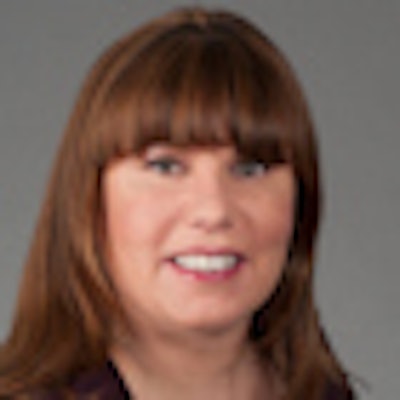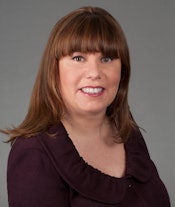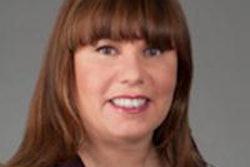
Not very long ago, it seems, (but indeed a very long time ago) I went to my first RSNA meeting. The largest medical meeting in the world, I was told. I was really impressed -- and I still am!
Standing in line in front of my hotel, waiting for the bus, I met a man -- a really friendly, delightful fellow who looked a bit odd, but one does not want to judge ... his coat was too small, as the sleeves came just below his elbow.
He perhaps felt uncomfortable, as he volunteered an explanation: He was wearing the department winter coat. His radiology department sent one radiologist a year to the RSNA show from his hometown in Queensland, Australia. As Australia has a tropical climate, no one really had a winter coat, so the department made do with just one that was entrusted to the lucky fellow to make the trek to Chicago in winter.
 Dr. Mary Morrison Saltz.
Dr. Mary Morrison Saltz.
Real winter -- with snow and storms. Winter in Chicago -- with the lights on Michigan Ave., parties, and camaraderie.
That first meeting was a glimpse of the future. Each year at RSNA, one gets a chance to peek ahead into the future: our future, the future of radiology.
Looking back, you see a bit of radiology's history. The first RSNA conference was in 1915 in -- yes, you guessed it -- Chicago. This was the start of a legacy.
Chicago has hosted the RSNA meeting many times since, although not every year. The Palmer House was for many years the epicenter of RSNA. The entire meeting was held there in the 1960s, but soon it could not hold all of our members. In 1975, the RSNA show moved to McCormick Place, with coordinated bus transportation from the downtown hotels to the convention center.
I remember the RSNA conference before the South Building was added to McCormick Place, an addition that made the facility the largest convention center in the U.S.
Another example of how radiology has changed: Back in the 1990s, there was a subtle competition among radiologists to have the best library; books were the talismans of learning, an outward display of inner knowledge. Each RSNA, a few more texts were acquired, adding to the depth of one's collection. Perhaps a new text on MRI techniques, or an update to the ultrasound library. It was always great to have them shipped home -- books are heavy!
Today, I came upon only one book table. I am sure there were more, but their place of prominence was gone. Our libraries are now electronic.
The future is data
So where are we today? RSNA 2012 was a great show. Our heads were in the cloud! Data, data, data: How to process it, what to do with it, how to make sense of it. Billing data, data analytics, patient data, outcomes research, radiology informatics.
As a profession, since the first CT scans, we have depended on computational miracles beyond the human capacity, at the intersection of physics and computer science. Yet now we depend on computers not only to generate and manipulate the images we read, but increasingly to provide information that can be mined to allow us to improve patient care and provide personalized radiology.
This gives us the ability to do more for less, using data to drive our decisions. Sharing patient information safely in the cloud; allowing real integration of imaging over many sites. This is the tip of the iceberg of what we will be doing with data in 10 years. This year, we see the future, and the future is data.
Data will allow us to step out of our black box of radiology and into our roles as physicians again. Today, radiologists are running flat out to generate information and reports as fast or faster than humanly possible. We have become dehumanized, overworked, and stressed.
Burnout is high, despite generous compensation and vacation time that is the envy of many other medical specialists. Why? Well, it's not simple, but sitting alone, in the dark, working through depersonalized, electronic worklists for nine to 10 hours a day can take its toll. Reading the same thing, day after day, can be tedious.
Once we can again read the interesting case and affect patient care, discussing the case with other caregivers, perhaps even with the patients themselves, we can return to our role as a true physician. As physicians, we need to grab our data-driven future and use it to make our lives better, and improve the care we deliver. Data can help us get there.
A new world of radiology
Imagine a world where we only see the interesting cases, the ones where there is a question; the rest are read by computers. A world where we do not have to "self-correct" routine dictations; instead, they are done right the first time, with the help of natural language processing.
As radiologists, we need to jump in and get involved -- with workflows, data analysis, and computerized voice recognition. Make it work for us. All of us need to get involved, or our new world will be created by others.
Why is it that the voice recognition software is trained to a Midwestern male voice? One RSNA informatics session I went to suggested that we all lower our voices to make voice recognition work better! Why not make the voice recognition better? My voice is rather fixed at this point.
One thing that struck me at RSNA 2012 was how overrepresented academic radiology departments were. It is they who are partnering with industry to develop new standards, which will be grafted onto the whole world of imaging.
That's great, but all radiology must get involved in shaping our future. The private practice radiologists cannot afford to let this transition be driven solely by our academic brethren. Workflows are what you make them, and what is important in an academic setting may be less so in a community hospital.
Working with residents changes how we work, and grafting that work model onto a private practice will not work. Unless we get involved, we risk having our new world built for us by folks who don't do our work, and don't understand how to do it well. We cannot be too busy to shape our own future.
Thought leaders should not come only from the academic side, or we will lose a real opportunity to shape our world -- through data -- into a better place to work and a better way to deliver care to our patients. We are not there yet, but the world is changing fast, and we will be there tomorrow. RSNA gave me a glimpse of that tomorrow.
Dr. Mary Morrison Saltz is a board-certified diagnostic radiologist who is currently the chief medical officer for Hospital Radiology Partners, a national radiology contract management and consulting company based in Atlanta.
She has served as radiology chair and service chief at hospitals in Florida, Ohio, and most recently at Emory Johns Creek Hospital in Johns Creek, GA. Dr. Saltz is a member of the American College of Physician Executives, the American College of Radiology, and the Radiological Society of North America, and she sits on the Citizens Advisory Council of the Duke Cancer Institute in Durham, NC.
Dr. Saltz has more than two decades of experience in turning around problem radiology departments in three states. As a hands-on leader, Dr. Saltz's expertise is working hand-in-hand with hospital administration to guide the radiology teams to success. Dr. Saltz has led quality assurance programs in Florida and Ohio, and served as chief quality officer for community practice initiatives at Emory Health Care. She also has more than 20 years of private practice experience.
She is a graduate of McGill University, with a Bachelor of Science in Human Genetics, and Duke University, where she obtained her Doctor of Medicine. Her postgraduate education included a residency at Boston University where she served as chief resident, and a fellowship in interventional abdominal radiology at Massachusetts General Hospital.
The comments and observations expressed herein do not necessarily reflect the opinions of AuntMinnie.com, nor should they be construed as an endorsement or admonishment of any particular vendor, analyst, industry consultant, or consulting group.



















